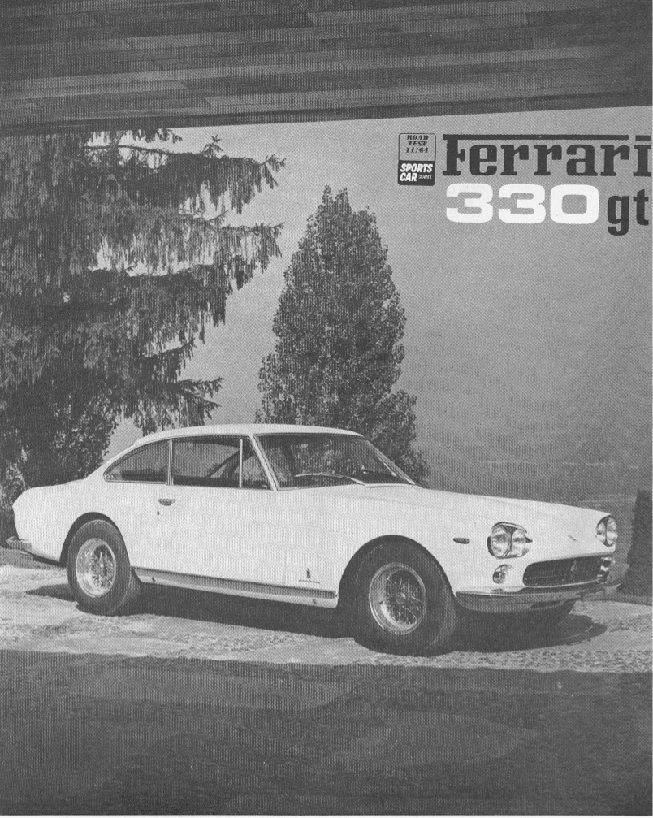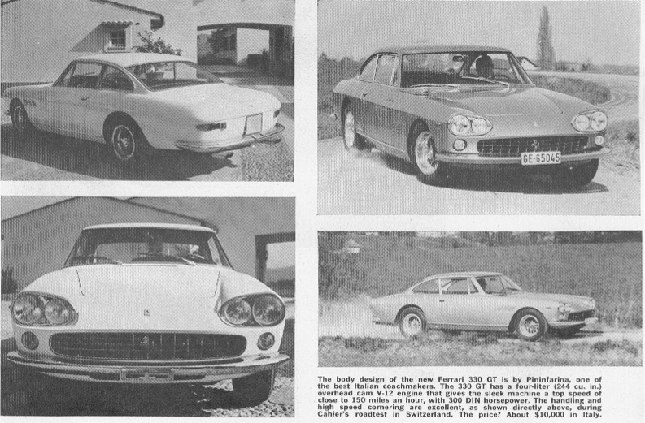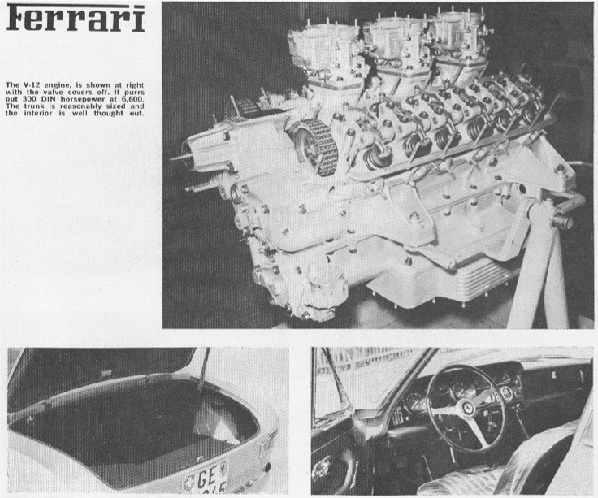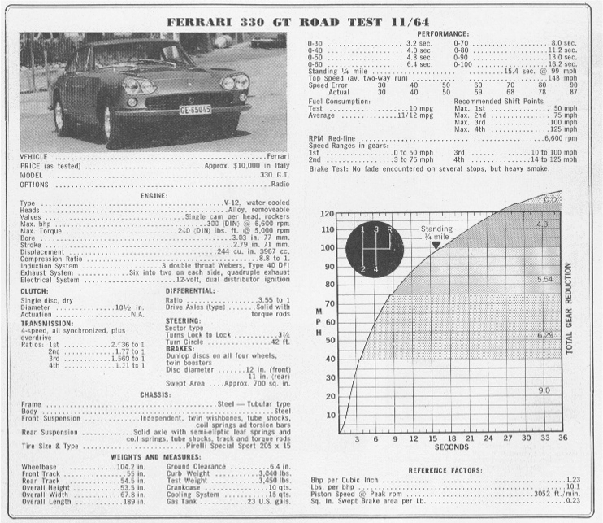 |
330 GT Registry |
 |
SPORTS CAR GRAPHIC AUGUST 1964

If you’re a little disappointed in your 250 GT Ferrari, take heart ...the 330 GT is a great deal better!
 The
Commendatore does not like to travel. It is well-known that outside of the
practice days of Monza you will never see Enzo Ferrari at a race, and this has
been going on for some thirty years. Do not think for a minute, however, that
Ferrari does not know what is going on in the automobile world. He is always
well-informed by a ring of friendly spies, and is always up to date in the
development of new cars, prototypes, trends of the various international
markets, etc. The creation of the new 330 GT is a good example of his knowledge
of these problems, and you can say that the 330 GT came at the perfect time to
replace the 250 GT, whose sales were no longer progressing. Obviously there were
reasons for that. One good one is that American Ferrari owners (an important
part of Ferrari’s total market), who had paid $12,000 and more for a 250 GT,
were getting pretty frustrated at being left behind at the stop lights by some
$4,000 American cars, some of them using (Oh, horror!) automatic transmissions.
True, Ferrari owners had the pride of owning the most glamorous name of all
sports cars, and no one can ever get tired of hearing the thrilling noise of
that beautiful 12-cylinder engine. Beautiful, too, was the body styling by
Pininfarina.
The
Commendatore does not like to travel. It is well-known that outside of the
practice days of Monza you will never see Enzo Ferrari at a race, and this has
been going on for some thirty years. Do not think for a minute, however, that
Ferrari does not know what is going on in the automobile world. He is always
well-informed by a ring of friendly spies, and is always up to date in the
development of new cars, prototypes, trends of the various international
markets, etc. The creation of the new 330 GT is a good example of his knowledge
of these problems, and you can say that the 330 GT came at the perfect time to
replace the 250 GT, whose sales were no longer progressing. Obviously there were
reasons for that. One good one is that American Ferrari owners (an important
part of Ferrari’s total market), who had paid $12,000 and more for a 250 GT,
were getting pretty frustrated at being left behind at the stop lights by some
$4,000 American cars, some of them using (Oh, horror!) automatic transmissions.
True, Ferrari owners had the pride of owning the most glamorous name of all
sports cars, and no one can ever get tired of hearing the thrilling noise of
that beautiful 12-cylinder engine. Beautiful, too, was the body styling by
Pininfarina.
Nevertheless three liters and 230 DIN horsepower did not seem quite enough to cope with certain American cars, and in Europe the E Type Jaguar and Aston Martin DB5 would actually accelerate quicker than the 250 GT two-plus-two. The time had come for the GT to grow up, and based on the fact that there is no substitute for the cubic inch for horsepower and torque, this year at Brussels Ferrari presented his new two-plus-two GT, now called the 330 GT. Styled by Pininfarina, the new 330 GT bears a certain resemblance to the 250 GT, but the lines are now more rounded, the car has twin headlights, and a bigger trunk with rounded contours actually quite similar to that of the Fiat 2300 coupe. It is a well balanced, elegant machine but in my opinion, and since it is a Ferrari, it could have been more exciting looking. True, Ferrari seldom changes models and usually exotic lines do not last, but still a Ferrari is a Ferrari and should look like something special.
The car I tested, by the way, was graciously lent to me by George Filipinetti, the Geneva Ferrari importer, who also runs the well-known Scuderia Filipinetti.
In dimensions the car is longer by four inches, and its wheel base of 104.2 inches is just about two inches longer than the 250 GT. The car is also slightly wider and higher, to allow more space inside. After all, the car is sold as a two-plus-two, and in the case of the 250 GT it was more fitted for two adults and two children. Now, thanks to its wider and longer dimensions, four adults can actually sit in the car without being cramped too much.
 The
interior is tastefully done and the dashboard is very attractive. The complete
range of instruments are well laid out, but when driving it I noticed that they
were not as visible as they could have been, mainly because of the small numbers
used on them. On the dash, close to the roomy glove compartment, there are two
welcome adjustable circular air vents and the inside cooling of the car is
completed by two side air vents under the dash. The leather covered seats are of
excellent quality and the large front bucket seats are very comfortable and
well-designed. The visibility is superb front and rear. The general finish is
good, but perhaps not as good as it should be for a car of that class.
The
interior is tastefully done and the dashboard is very attractive. The complete
range of instruments are well laid out, but when driving it I noticed that they
were not as visible as they could have been, mainly because of the small numbers
used on them. On the dash, close to the roomy glove compartment, there are two
welcome adjustable circular air vents and the inside cooling of the car is
completed by two side air vents under the dash. The leather covered seats are of
excellent quality and the large front bucket seats are very comfortable and
well-designed. The visibility is superb front and rear. The general finish is
good, but perhaps not as good as it should be for a car of that class.
Under the hood sit the major modifications of the car as the three-liter 12-cylinder engine has been replaced by a big new four-liter 12-cylinder, generously fed by three big double-throat downdraft Weber carburetors. As it is, this big engine is mildly tuned to give a maximum of smoothness and silence, but nevertheless puts out a healthy 300 horsepower at 6,600 rpm, with a maximum torque of 240 lb-ft at 5,000 rpm. For comparison, the three-liter engine used in the 250 was giving between 230 and 240 horsepower at 7,000 rpm, with a maximum torque of 184 lb-ft at 5,500 rpm. As we can see, the horsepower and torque increase is very significant and was not gained at the expense of the smooth ness of the engine—on the contrary. Also it is interesting to notice that the four-liter engine is no larger in overall dimensions than the three-liter, and it weighs only a few pounds more.
Other significant improvements made on the new 330 GT are a dual brake system for extra safety, rear suspension of the GTO type, with leaf springs now assisted by helicoidal springs, torsion bar and torque arms, and a new type of overdrive which cuts off automatically as soon as you shift from fourth to third.
Largely responsible for the development of the 330 GT was Michael Parkes who, as our readers probably know, is not only an engineer but a talented racing driver as well, as shown by his victory in the latest 12 hours of Sebring. Parkes has done intensive testing on the 330 GT and has succeeded brilliantly in giving a softer, more comfortable ride to the car and yet improving the road handling. Normally a car to which you give a softer ride leans more in curves and, at speed, the general handling suffers from the soft suspension. This is not at all true in the case of the 330 GT and two days of driving with this superb machine convinced me that Ferrari has reached a new standard of comfort and handling in the field of so-called production sport GT cars.
For those who have driven the 250 GT two-plus-two, the changes and improvement in this new car will be felt immediately. The car is quiet, the engine smooth, and yet full of horsepower in every range. The ride is very comfortable and the handling is definitely better. Right away you have the feeling that you are dealing with a very refined car, which does not mind in the least being driven at city speeds. The extra horsepower and torque given by the new four-liter engine have strikingly improved the car’s behavior in town. For those who do not like town shifting the 330 GT can be driven in top gear at as low as 15 mph, and this without any protest from the engine which still, if you put your foot down at that speed, will accelerate smoothly and quickly to its maximum speed.
 For
those interested by the sporty side of the Ferrari (and who isn’t?) the car
really shows its teeth in an aggressive manner if you want to put it through the
gears at maximum revs. The accelerations are indeed more than rewarding. With
two people aboard and a pretty well-filled gas tank you reach 50 mph in 4.8
seconds, 60 in 6.4 seconds, 80 in 11.2 and 100 in 16.2 seconds, while the
standing quarter of a mile was done in a very satisfying 15.4 seconds. These
figures are really putting Ferrari in the class of cars where it belongs, and
although there are a few faster accelerating cars on the road, the difference is
now minimal and the 330 GT is well up with the leaders.
For
those interested by the sporty side of the Ferrari (and who isn’t?) the car
really shows its teeth in an aggressive manner if you want to put it through the
gears at maximum revs. The accelerations are indeed more than rewarding. With
two people aboard and a pretty well-filled gas tank you reach 50 mph in 4.8
seconds, 60 in 6.4 seconds, 80 in 11.2 and 100 in 16.2 seconds, while the
standing quarter of a mile was done in a very satisfying 15.4 seconds. These
figures are really putting Ferrari in the class of cars where it belongs, and
although there are a few faster accelerating cars on the road, the difference is
now minimal and the 330 GT is well up with the leaders.
At top speed the car is no slow mover either, with a recorded maximum of 148 mph. At this speed the car is no problem to drive. In fact, in the higher speed range (which I would say was anything over 100 mph) there is very little sensation of speed simply because the car feels so safe and stable on the road. The engine noise, which becomes much more audible above 5,000 rpm, reminds you that you are going fast, but other wise there is a rather rare absence of speed feeling. This is very pleasant and restful for somebody capable of handling a car cruising effortlessly at over 100 mph, but might be a problem for someone not used to really fast driving and who might buy such a car. Indeed the person driving has the feeling he might be doing 60 when he is actually doing 100 and more. As you have read above, you do reach 100 mph very quickly, in 16 seconds, and if for example you are in top gear at 50 mph, it will only take you just over five seconds to reach 100 mph.
Ferrari’s four speed gearbox is first class and operated by a short, quick action stick shift. The gearbox ratios are very good and, in the car I drove, first would go to 50 mph, second to 75 mph, third to 100, fourth to 125 mph, and with the overdrive you would get 148 mph at about 6,400 rpm.
Fast highways with long curves, and tight back country roads never found our 330 GT at fault, and I came back very enthusiastic about the handling of this car after my test, which incidentally was done under perfect weather conditions. Basically the car under- steers very slightly, but as soon as you set the car into a corner, particularly medium and slow corners, you can alter this tendency into some well-balanced oversteering and come out of the corner fast and in fine shape. I say “well balanced” because, thanks to the combination of the new rear suspension, self locking differential and wide base Pirelli tires, the back is remarkably steady and controllable. Although you will actually leave marks on the ground when accelerating brutally, there is a minimum of wheel spin and the tire adhesion feels great at all times. On tight corners the steering is a bit heavy, but generally speaking it is a very pleasant steering, precise and direct enough, with 31/4 turns from lock to lock. The brakes felt extremely powerful but mine had a certain feeling of sponginess at times, a bit like an E-Type Jaguar, and I hope it was just an incident on mine, as it is not very pleasant. Incidentally, for those who have suffered from having Ferrari exhaust pipes touching the ground, the ground clearance of the 330 GT has been made higher, and I think it is a good thing.
It is always with regret that you have to hand back a car like a Ferrari, a car which is a thrill to drive, as well as opening new horizons to you. For man like me, who does not own one, a Ferrari such as this gives one a deep feeling of pleasure, a bit like going on an adventure, and you feel as though you would like to drive it far, far away into a land of sunshine and voluptuous living. But back on earth, at the wheel of my Mini, I was thinking of how much work, research and love must have gone into the realization of the new 330 GT, which no doubt is setting a new standard of Grand Touring driving with that very difficult combination to get—speed, comfort, styling and handling. Priced at $10,000 picked up at the factory, it is not a cheap item, but I do not think anyone expects the Prancing Horse to be sold for a mere few thousand dollars.—Bernard Cahier
SPORTS CAR GRAPHIC U.S. Copyright 1964